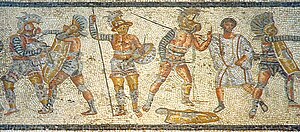334
Appearance
| Millennium: | 1st millennium |
|---|---|
| Centuries: | |
| Decades: | |
| Years: |
| 334 by topic |
|---|
| Leaders |
| Categories |
| Gregorian calendar | 334 CCCXXXIV |
| Ab urbe condita | 1087 |
| Assyrian calendar | 5084 |
| Balinese saka calendar | 255–256 |
| Bengali calendar | −259 |
| Berber calendar | 1284 |
| Buddhist calendar | 878 |
| Burmese calendar | −304 |
| Byzantine calendar | 5842–5843 |
| Chinese calendar | Quý tịNăm (WaterSnake) 3031 or 2824 — to — Giáp ngọ năm (WoodHorse) 3032 or 2825 |
| Coptic calendar | 50–51 |
| Discordian calendar | 1500 |
| Ethiopian calendar | 326–327 |
| Hebrew calendar | 4094–4095 |
| Hindu calendars | |
| -Vikram Samvat | 390–391 |
| -Shaka Samvat | 255–256 |
| -Kali Yuga | 3434–3435 |
| Holocene calendar | 10334 |
| Iranian calendar | 288 BP – 287 BP |
| Islamic calendar | 297 BH – 296 BH |
| Javanese calendar | 215–216 |
| Julian calendar | 334 CCCXXXIV |
| Korean calendar | 2667 |
| Minguo calendar | 1578 beforeROC Dân trước 1578 năm |
| Nanakshahi calendar | −1134 |
| Seleucid era | 645/646AG |
| Thai solar calendar | 876–877 |
| Tibetan calendar | Âm rắn nước năm (female Water-Snake) 460 or 79 or −693 — to — Dương ngựa gỗ năm (male Wood-Horse) 461 or 80 or −692 |

Year334(CCCXXXIV) was acommon year starting on Tuesday(link will display the full calendar) of theJulian calendar.At the time, it was known as theYear of the Consulship of Optatus and Caesonius(or, less frequently,year 1087Ab urbe condita). The denomination 334 for this year has been used since the early medieval period, when theAnno Dominicalendar erabecame the prevalent method in Europe for naming years.
Events
[edit]By place
[edit]Roman Empire
[edit]- Flavius Dalmatiusputs down a revolt inCyprus,led byCalocaerus.Calocaerus is brought toTarsus(Cilicia), and executed.[1]
- TheGothsprotect theDanubefrontier against an invasion by theVandals.[2][3]
- EmperorConstantine the Greatreauthorisesgladiatorialcombat.
Births
[edit]- Huiyuan,ChineseBuddhistteacher and founder ofDonglin Temple(d.416)[4]
- Sabbas the Goth,Christianreaderandsaint(d.372)[5]
- Virius Nicomachus Flavianus,Roman historian and politician (d.394)[6]
Deaths
[edit]- December 5–Li Ban,Chinese emperor ofCheng-Han(b.288)
- Calocaerus,Romanusurper[1]
- Li Xiong,Chinese emperor of Cheng-Han (b.274)[7]
- Shi Hong,Chinese emperor of theJie state(b.313)[8]
- Tao Kan(orShi xing), Chinese general and politician (b.259)[9]
- Wei Huacun(orXianan), Chinese religious leader (b.252)[10]
- Yang Nandi,Chinese general and ruler ofChouchi
References
[edit]- ^abPohlsander, Hans A. (2004).The Emperor Constantine(2nd ed.). Routledge. p. 78.ISBN978-0-415-31938-6.
- ^Kraitser, Charles V. (1837).The Poles in the United States of America.Kiderlen and Stollmeyer. p. 17.
- ^Townsend, George Henry (1862).The Manual of Dates(2nd ed.). Routledge, Warne & Routledge. p. 757.
- ^Zürcher, Erik (1959).The Buddhist conquest of China.Vol. 1. Brill Archive. p. 16.
- ^Hodgkin, Thomas (1892).Italy and Her Invaders.Vol. 1 (2nd ed.). Clarendon Press. p. 178.
- ^Adkins, Lesley; Adkins, Roy A. (2004).Handbook to life in ancient Rome(2nd ed.). Infobase Publishing. p. 17.ISBN978-0-8160-5026-0.
- ^Mutschler, Fritz-Heiner; Mittag, Achim (2008).Conceiving the empire: China and Rome compared.Oxford University Press. p. 397.ISBN978-0-19-921464-8.
- ^Frédéric, Louis (1977).Encyclopaedia of Asian civilizations.Vol. 3. p. 178.
- ^Pearce, Scott (2001). Spiro, Audrey G.; Ebrey, Patricia Buckley (eds.).Culture and Power in the Reconstitution of the Chinese Realm, 200–600.Harvard Univ Asia Center. p. 76.ISBN978-0-674-00523-5.
- ^Liu, Cheng-Tsai; Zheng-Cai, Liu; Hua, Ka (1999).A Study of Daoist Acupuncture.Blue Poppy Enterprises, Inc. p. 17.ISBN978-1-891845-08-6.
